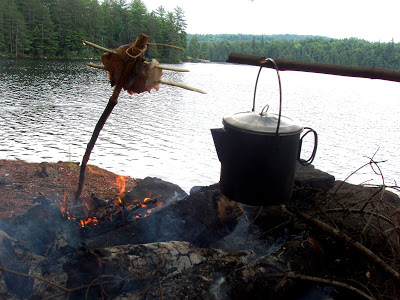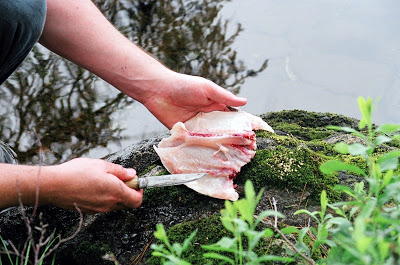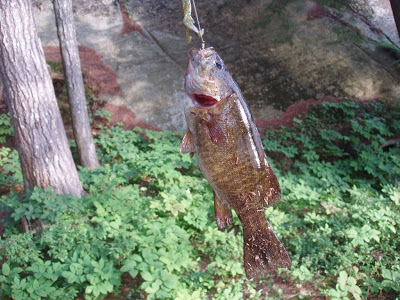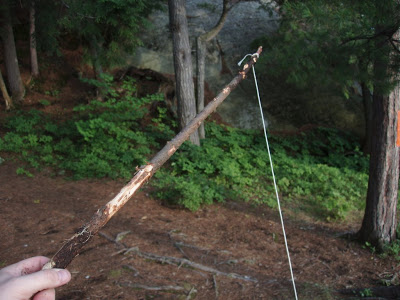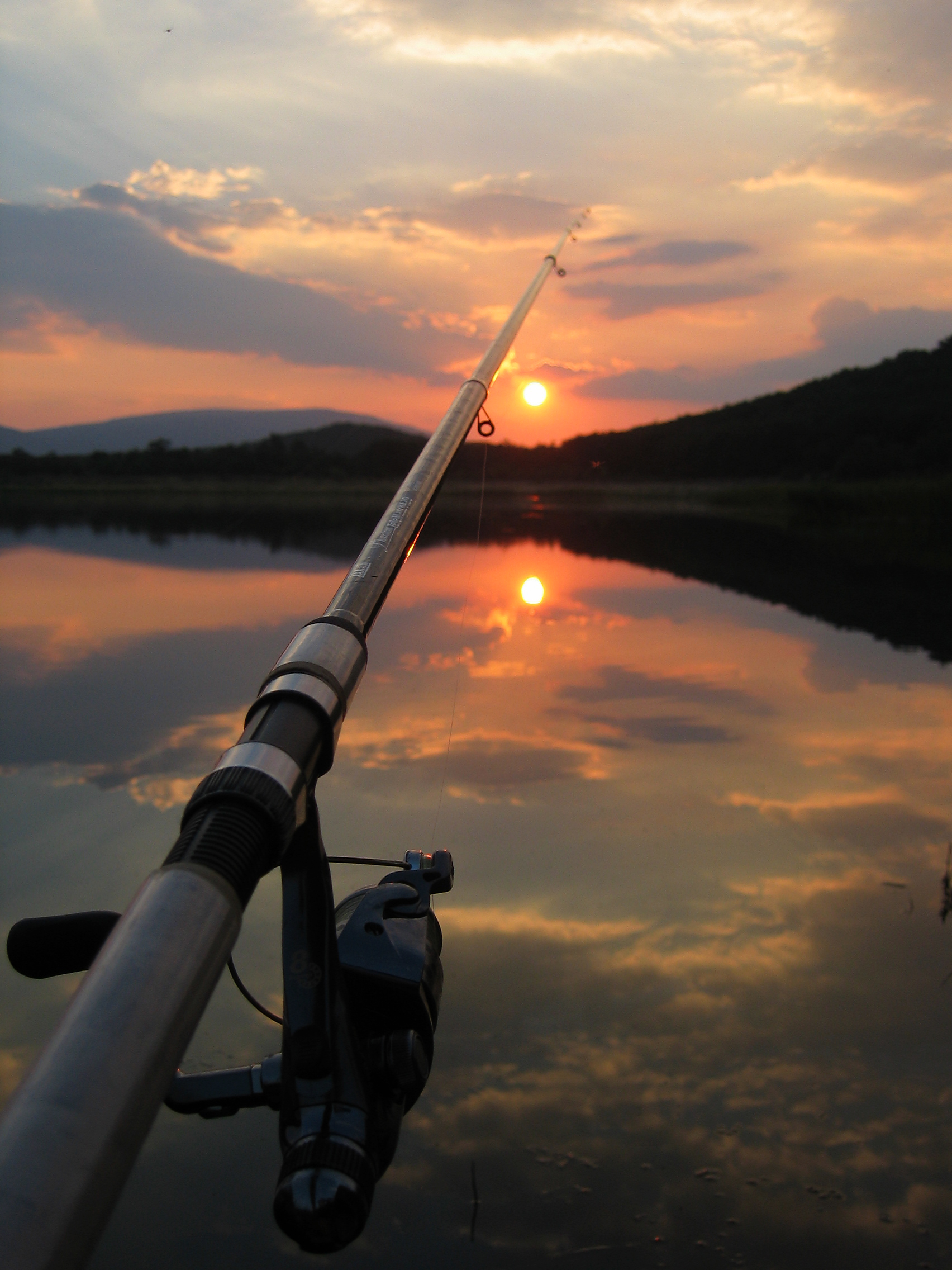Spring is here and its the best time to get outdoors and go camping! Fishing is a great way to spend a leisurely day and the first bite of fresh fish can be unforgettable, especially when you’re the one who has caught it. We love ‘first times’ and hence compiled this article for all those who have given this a thought but haven’t gotten down to doing it yet. So here goes! Firstly, trek to a good spot – a good fishing hole is where you can see fish swimming and jumping. A slow moving stream or slow place in a river with rock swirls and dead trees that create a pool are perfect. Early morning and late evening are good fishing times as fish are hungry but on hot afternoons they head deep to stay cool.
The simplest way to catch a fish when camping is to start off with 5 simple items: a nice sharp knife – a carbon-steel Mora will do nicely, a simple fish-hook and lure, a length of string or fishing line, and finally a fishin’ pole – a carved stick! There are several ways to better your chances at catching a fish so here are some awesome tips to get you going:
- Fish notice shadowy shapes on the banks, so sit low if you can, or stay by a tree, and above all try to reduce your noise-level and movement.
- If you’re not catching after a few minutes in one location, move to another.
- Fishing on the lee shore (i.e. the side of the shore where the wind blows off the woods and into the water) will increase your chances as the fish congregate to eat the insects that blow from the trees into the shore waters. They’re more apt to go for your lure in these circumstances.
- Throw your lure near holes in the water floor, near boulders, exposed roots, or floating vegetation.
- Fish like to stay close to objects in the water – they feel safer there from larger predator fish.
- When the fish bites, yank the hook so as to set it deep. The last thing you want is for the fish to get spooked and drop the hook on the way up to the surface.
Once you’ve caught fish, take it out to the shore. Bonk it on the back of the head with something heavy to end it quickly (i.e. terminate with extreme prejudice) and remove the hook carefully. It is now time to clean your fish. It’s easy and you’ll be done in a minute. You can scrape the scales off, make the first cut by inserting your sharp knife into the vent in the belly of the fish right in front of the anal fin and slice out forwards towards the gill region. Watch your fingers. Split the gills’ central connection. Now take out the intestines, liver and other internal organs from the gut cavity – a quick wipe with a cloth will achieve this. Cut out the gills too. Once mostly clean inside, just give the insides a rinse and wash out any blood that you can see.
Now – getting the fish ready to cook depends on how you want to cook it… If you want it whole, you could just stuff it with aromatics (juniper and blue berries etc…), wrap it in leaves and place it in the embers of a burned down fire or just throw it on a grill. You could cut it up into pieces and make a fish soup with it. Our preferred way is to grill it over an open fire. To do this, open it up from the belly with your knife and remove the backbone, ribs, head and tail – leaving just a flat double fillet with the skin on. Remove the fins with deft cuts from your knife and mind you don’t get poked – they can be sharp and slippery. You can remove the ribs and bones just before removing the backbone by slipping your thumb from just behind the head and drawing down between the meat and the rib cage all the way down the length of the fish. Without a frying pan, you can make a simple frame. Slip 2 or 3 debarked deciduous branches (coniferous sticks are resinous and this will leave a poor taste in the fish) about the thickness of a pencil into opposing holes on the edges of the fillet. Then slip this all perpendicular through a thicker split branch – split about 12 inches down the shaft. Bind one or both ends as needed with split spruce roots or twine. Push the shaft of the supporting stick into the ground or brace it with stones, and position the fish close enough to the fire. Shortly you’ll be able to settle down to a meal of fire-braised fish. Mmm.
Don’t forget to send us your pictures, write to us with your experience at zinia@indiayachtpage.com
This article was compiled from: http://www.mungosaysbah.com/2008/02/how-to-catch-clean-and-cook-fish-while.html
If you want to fish please only take enough fish to feed yourself and only fish if you are going to eat the fish and not waste them. Fish populations can be wiped out if people over fish an area and do not make an effort to take only what they will eat and leave the rest to breed and produce more fish. Care for mother earth and she will provide for you!
For more information on fishing tackle and angling equipment, get in touch with Casa Ibrahim in Goa. Their products include a variety of fishing tackle:
Rods and reels: We have spinning rod and reel combos, spinning rods, boat rods, surf rods, baitcasting rods, jigging rods, trolling rods, fly rods, interline rods, telescopic rods, spinning reels, surf reels, baitcasting reels, trolling reels, level wind reels, line counter levelwind reels, fly reels.
Lines: Monofilament lines, hybrid lines, fluorocarbon lines, braided lines, hyper lines.
Lures: trolling lures, jigs, spinners, poppers, vibrating lures, swimbaits, soft baits, multi-jointed lures, squid jigs, shrimps.
Hooks: commercial hooks, bait –holder hooks, stainless steel hooks, chinu hooks, treble hooks, sabikis.
Rigging accessories: Swivels, snaps, rolling inter-snaps, split rings, split shots, wire leaders, double sleeves.
Accessories: Rod racks, tackle boxes, Fishing headlamps, floats, crimping pliers, hand castors.
Phone : 0832-2512643
Mobile: 09822127186
e-mail: casaibrahim@yahoo.com
e-mail: info@casaibrahim.com
Contact person: Mr. NasirShaik.
Website: www.casaibrahim.com

